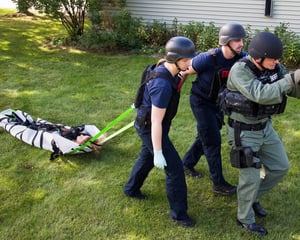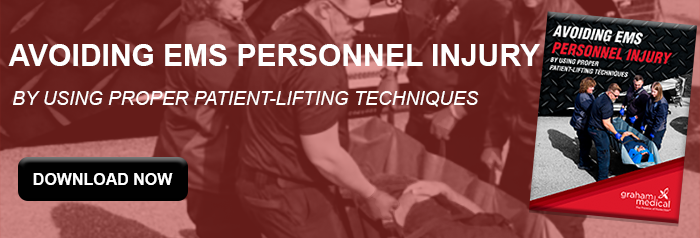
According to the CDC, emergency medical technicians (EMT) and paramedics experience significantly more injuries than the general workforce. A significant portion are lower back injuries as a result of lifting, moving and handling incapacitated patients.
The situation is so serious that in the first four years of service, 25 percent of EMS practitioners have career-ending injuries. The most common reason why EMTs and paramedics leave EMS is back injuries.
Why EMT Injury Rates Are So High
According to the CDC, of the 27,000 injuries suffered by first responders in 2011, more than 21 percent were to the lower back. Often, these injuries are the result of attempts to lift and move patients. Although safe lifting devices help, they often can't be used due to poor access. Instead, first responders must manually extricate patients to where they can be placed onto a stretcher.
The conventional approach of two-man EMS teams often means lifting loads are excessive, and is exacerbated by poor lifting techniques that place extra shear and rotational force on spines, resulting in musculoskeletal injury.
Prevent Injuries by Recognizing Physical Limitations
Despite a prevailing attitude that two people should be able to lift and carry an injured person, research indicates this is not the case. The National Institute for Occupational Safety and Health lifting equation sets the maximum safe lifting load for a single person at 51 pounds for a static load under ideal conditions. When handling patients, where loads are unpredictable and surfaces may be less than optimum, the limit is 35 pounds. Above this limit, responders need assistive devices. This explains why there are so many EMS back injuries and illustrates the importance of limiting lifting load to prevent first provider injuries.
Dragging Is A Viable Alternative to Lifting Patients
When researching solutions for mass casualty incidents, Graham Medical enlisted the help of Captain Michael Wright, a fire captain and paramedic from Milwaukee. Captain Wright has extensive experience with MegaMover® transport unit. Recognizing that the paramedic-to-patient ratio is invariably poor, the team realized dragging patients held securely in suitable transport unit is easier than carrying patients. As Captain Wright said: "Dragging the patient where possible is important — it exerts less energy for the first responder." The same philosophy applies to any situation where EMS need to access patients where conventional stretchers are impractical.
MegaMover® Flexible Transport Systems Reduce EMT Body Strain
MegaMover® products include a range a flexible patient transport solutions that reduce the physical load on first responders' backs because:
- Patients are strapped in securely
- Units naturally fold around the patient's body
- Numerous handholds allow teams to equally share the load
- A strong non-woven construction suitable for large and heavy patients
- Head straps that can be used to drag patients
- Single-use design
New products that exploit the ability of first responders to move patients easily include:
- The MegaMover® Disaster Response that can be used to drag or carry patients to safety during mass casualty incidents.
- The MegaMover® Tactical for speedily dragging patients out of harm's way in mass shooting incidents.
While it's essential to use proper lifting tactics, these MegaMover® products help reduce the strain on EMS personnel while keeping patients safe. Learn more about keeping your staff safe and avoid EMS back injuries with this eBook from Graham Medical. Contact us for further information.

